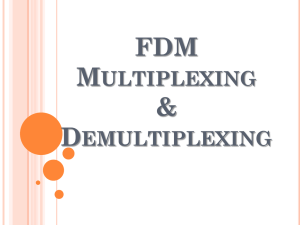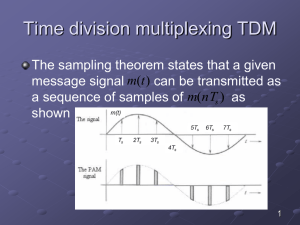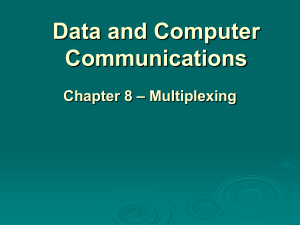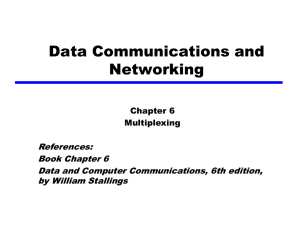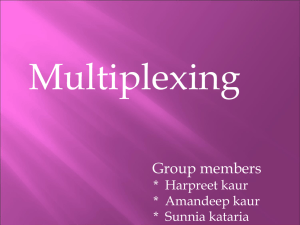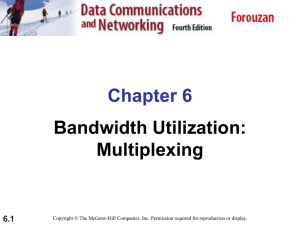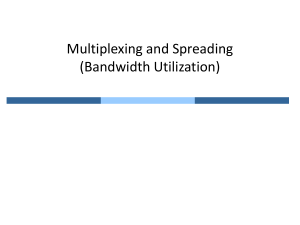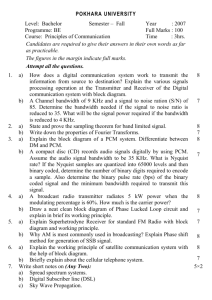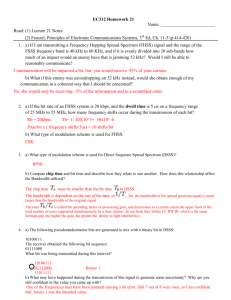Chapter 9 Access Methods - ISY: Communication Systems
advertisement
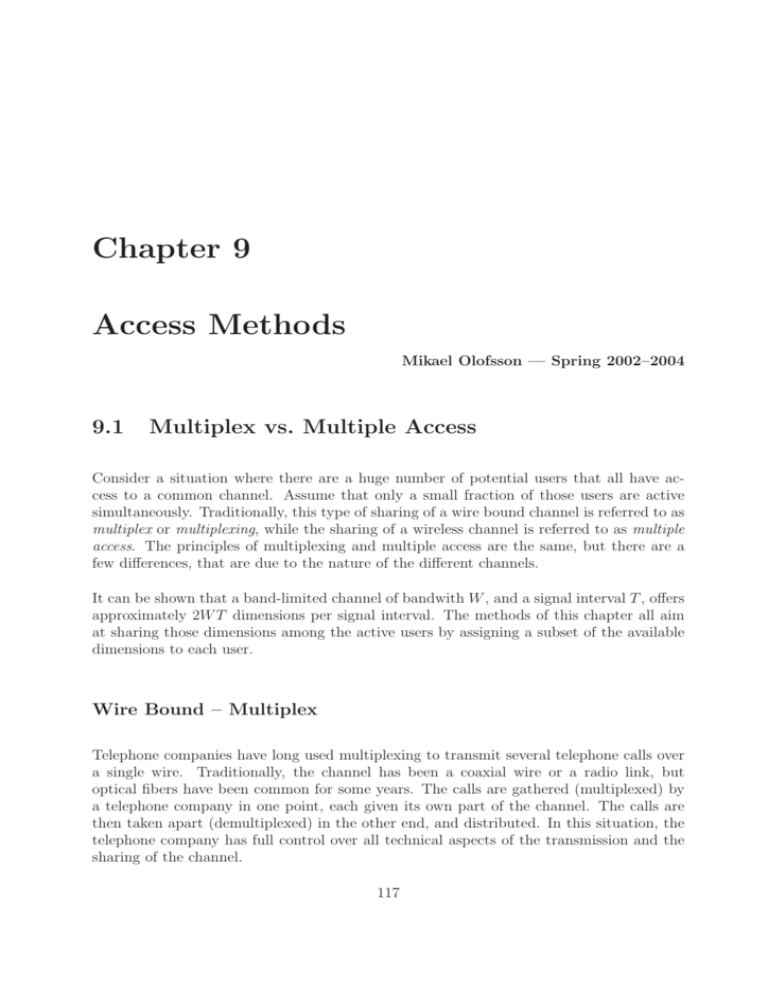
Chapter 9
Access Methods
Mikael Olofsson — Spring 2002–2004
9.1
Multiplex vs. Multiple Access
Consider a situation where there are a huge number of potential users that all have access to a common channel. Assume that only a small fraction of those users are active
simultaneously. Traditionally, this type of sharing of a wire bound channel is referred to as
multiplex or multiplexing, while the sharing of a wireless channel is referred to as multiple
access. The principles of multiplexing and multiple access are the same, but there are a
few differences, that are due to the nature of the different channels.
It can be shown that a band-limited channel of bandwith W , and a signal interval T , offers
approximately 2W T dimensions per signal interval. The methods of this chapter all aim
at sharing those dimensions among the active users by assigning a subset of the available
dimensions to each user.
Wire Bound – Multiplex
Telephone companies have long used multiplexing to transmit several telephone calls over
a single wire. Traditionally, the channel has been a coaxial wire or a radio link, but
optical fibers have been common for some years. The calls are gathered (multiplexed) by
a telephone company in one point, each given its own part of the channel. The calls are
then taken apart (demultiplexed) in the other end, and distributed. In this situation, the
telephone company has full control over all technical aspects of the transmission and the
sharing of the channel.
117
118
Chapter 9. Access Methods
Wireless – Multiple Access
With the advent of mobile communication, we have been blessed with yet another term:
Multiple access. When a mobile wants access to the channel, it tells the nearest base station
so, typically over a separate channel. The base station assigns a part of the channel for
the call, but it is up to the mobile to actually use the assigned part of the channel.
There are a number of special problems connected to mobile wireless communication. One
is the near-far effect. Mobiles that are on different distances from the base station result
in different signal power at the base station. The difference can be huge, which means that
the stronger signal may cause cross-talk to the weaker signal if the corresponding parts of
the channel are not enough separated. This problem is dealt with by power control, by
estimating the channel.
Another problem is time accuracy. Again, mobiles can be located at different distances
from the base station, which causes different delays. The time references of the mobiles may
also differ. A third problem is frequency accuracy. The moving property of mobiles may
cause doppler shifts, which means that the spectrum is shifted. The frequency reference
of the mobiles may also differ. Finally, multipath transmission causes problems. This
causes frequency selective fading, which tends to make individual frequency bands useless
for longer or shorter time intervals.
9.2
Frequency Division
Basic Idea
One way to supply several parts of the available channel is to divide the frequency band
into several smaller frequency bands. The methods based on this idea are called
• FDM – Frequency Division Multiplex
• FDMA – Frequency Division Multiple Access
The sharing of the common channel is displayed in Figure 9.1. A simple example of
frequency division is ordinary radio broadcasts. Each radio station uses a certain frequency
band, decided upon by some authority. A receiver is tuned in on a desired radio station,
and simply works as a BP filter, where the tuning determines the center frequency of that
filter.
9.2. Frequency Division
119
f
Guard band
Subchannel
W
t
Figure 9.1: The sharing of a common channel in FDM(A).
60 voice
channels
600 voice
channels
3 jumbo
groups
3600 voice
channels
Jumbo group
multiplexer
Supergroup
generation
Channel group
generation
12 voice
channels
16 master
groups
Jumbo group
generation
10 supergroups
5 channel
groups
Master group
generation
12 voice
channels
10 800 voice
channels
Figure 9.2: The overall structure of the multiplexing in the Bell FDM system.
An Example: The Bell FDM System
The Bell FDM system for multiplexing ordinary telephone calls is widely used. It is a purely
analog system that is based on repeated amplitude modulation, as shown in Figure 9.2. A
detailed picture of the first step, the channel group generation, is given in Figure 9.3. The
other steps are performed in similar ways. The spectrum of a supergroup is indicated in
Figure 9.4. Totally, 10 800 one-directional voice channels can be distributed over a single
channel. Those voice channels share a bandwidth of a little over 40 MHz.
This system is used in a telephone exchange office to transmit phone calls to another
telephone exchange office, where the phone calls are demultiplexed by filtering and demodulation. The pilot signals indicated in Figures 9.3 and 9.4 are used at the receiving
120
Chapter 9. Access Methods
Base-band
signal
0
DSB-SC
LSB
4
104
SSB-SC
USB
LSB
112
108
LP
filter
Channel 1
0.3 – 3.4 kHz
104
108
BP
filter
cos(2π · 108 · t)
Channel
group
output
60 – 108 kHz
BP
filter
LP
filter
Channel 12
0.3 – 3.4 kHz
104.08 kHz
pilot signal
BP
filter
cos(2π · 64 · t)
LSB
0
4
60
USB
64
12
Channel number:
60
LSB
68
11
64
60
10
68
104.08 kHz
pilot signal
7
8
9
72
64
76
80
6
84
4
5
88
92
2
3
96
100
1
104
108
Figure 9.3: Generation of a channel group in the Bell FDM system. The carrier frequency fk used
for channel number k, 1 ≤ k ≤ 12, is given by fk = 112 − 4k kHz. The frequency scale
of the indicated spectra is in kHz.
547.92 kHz
pilot signal
Channel group 1
Channel group 3
Channel group 2
Channel group 4
Channel group 5
1
12 1
12 1
12 1
12 1
12
312
360
408
456
504
552
Figure 9.4: A supergroup in the Bell FDM system formed from five channel groups, totally 60 voice
channels. The frequency scale of the spectrum is in kHz.
9.2. Frequency Division
121
end to generate carriers of the correct frequencies. The demultiplexed signals are then
furter distributed, some of them possibly multiplexed again to be transmitted to another
exchange office.
The system is obviously one-directional, while phone calls are two-directional. Therefore
those systems are used in pairs, one system for each direction.
Advantages and Disadvantages
The advantages of FDM(A) include the following.
• The assigned frequency band is continuously available. This means that this method
is insensitive to delays. Also, that means that an individual mobile does not need to
be synchronized to other mobiles.
• The narrow-band subchannel that is used for the communication poses low demands
on the radio parts, including modulators and demodulators. These parts need only
to deliver linearity within a narrow-band subchannel.
• The peak power is approximately the same as the average power, since each mobile
uses its subchannel continuously.
The disadvantages of FDM(A) include the following.
• The narrow-band subchannel poses high demands on frequency stability. Due to the
problem with frequency inaccuracy in the mobile case, this method needs a guard
band between the used frequency bands, in order to avoid cross-talk. These guard
bands cost dimensions.
• A related issue is high demands on filters. These typically need to be of high degree,
and the cutoff frequencies of those filters need to be exact.
• The metod is sensitive to frequency selective fading, since each mobile is assigned a
narrow-band subchannel. This means that the channel can be completely blocked
during relatively long periods of time.
122
9.3
Chapter 9. Access Methods
Wavelength Division
In the optical case, where we use an optical fibre as the channel, it is possible to communicate over the channel using light of more than one wavelength. Even though this is the
same idea as FDM (or FDMA), the methods are then called
• WDM – Wavelength Division Multiplex,
• WDMA – Wavelength Division Multiple Access.
The choice of carrier wavelengths is then limited to the wavelengths for which there exist
good laser diodes. One obvious difference between WDM(A) and FDM(A) is that the
frequencies used in WDM(A) are much higher than the frequencies used in FDM(A), since
we are transmitting visible light.
9.4
Time Division
Basic Idea
Another way to supply several parts of the available channel is to divide the time axis into
several disjoint intervals, one interval for each mobile. These intervals are then repeated,
so that each mobile is given access to all of the available bandwidth during a short period
of time, which is repeated after a while. The methods based on this idea are called
• TDM – Time Division Multiplex
• TDMA – Time Division Multiple Access
The sharing of the common channel is displayed in Figure 9.5. In digital electronics, this
method is often used to transmit binary data from one part of a device to another. It is
then simply referred to as multiplexing/demultiplexing or parallel-to-serial conversion and
serial-to-parallel conversion.
An Example: The Bell TDM System
The Bell TDM system is a digital system based on TDM for multiplexing phone calls. The
over-all structure of the system is given in Figure 9.6. The analog voice channel is sampled
using the sampling frequency 8 kHz, and each sample is quantized to 8 b/sample using
non-uniform quantization, and those bits are transmitted. This results in a data rate of
64 kb/s for one channel. This is done by a digitizer as in Figure 9.7.
9.4. Time Division
123
Guard interval
f
Subchannel
W
t
Figure 9.5: The sharing of a common channel in TDM(A).
24 voice
channels
96 voice
channels
672 voice
channels
Two
T4 frames
4032 voice
channels
T5 frame
generation
T2 frame
generation
T1 frame
generation
One digital
voice channel
Six
T3 frames
T4 frame
generation
Seven
T2 frames
Four
T1 frames
T3 frame
generation
24 voice
channels
Digitizer
PCM generation
Analog voice
channel
8064 voice
channels
Figure 9.6: The overall structure of the multiplexing in the Bell TDM system. Systems may not
use all of those steps, depending on the bandwidth of the channel at hand.
Analog
input
0.3 – 3.4 kHz
LP
filter
Sample
and hold
A/D
converter
Parallel
to serial
Digital
output
64 kb/s
Figure 9.7: A voice channel digitizer for the Bell TDM system. The sampling frequency is 8 kHz,
and each sample is converted to eight bits by the A/D converter.
124
F
Chapter 9. Access Methods
M
S
B
Channel 1
8 bits
L M
S S
B B
Channel 2
8 bits
L
S
B
Channels 3 through 22
8 bits each
M
S
B
Channel 23
8 bits
L M
S S
B B
Channel 24
8 bits
L
S
B
Figure 9.8: A frame in the Bell TDM system formed from 24 digital voice channels. The slot labelled
“F” is the framing bit. A frame consists of 192 data bits (24 × 8) and one framing bit,
totally 193 bits. The bits of each channel is transmitted with most significant bit first.
Twentyfour digital voice channels are multiplexed to form a T1 frame together with an
extra framing bit for syncronization. Such a frame is depicted in Figure 9.8. The following
formations of T2 through T5 frames are done in similar ways as the formation of a T1
frame, i.e. by multiplexing the smaller frames and appending syncronization bits. Each
frame is 125 µs long, since the sample frequency is 8 kHz.
Twelve consecutive T1 frames form a T1 superframe. Things vary between the individual
frames within a superframe. For instance, the least significant bit is ignored in frames six
and twelve. Those bits are instead used as control bits. The framing bit varies between
consecutive T1 frames in a superframe according to the pattern 1000 1101 1100. The
demultiplexer has a time reference that is syncronized by correlating against this pattern.
Each superframe is 1.5 ms long.
This system is one-directional just as the Bell FDM sytem, while phone calls still are twodirectional. Therefore those systems are also used in pairs, one system for each direction.
Advantages and Disadvantages
The advantages of TDM(A) include the following.
• The bandwidth is large, since the mobiles are not separated in terms of frequencies.
This poses low demands on filters.
• Each mobile uses the same bandwidth. Thus, the radio parts of the base station can
be reused for each mobile, which simplifies the implementation of those parts.
• The method is insensitive to frequency selective fading, since each mobile has access
to all of the available bandwidth, during its time interval. A suitable error correcting
code and/or modulation scheme can be used to eliminate the effects of this fading.
9.5. Code Division
125
The disadvantages of TDM(A) include the following.
• The method poses high demands on synchronization. Due to the problem with time
inaccuracy in the mobile case, this method needs a guard interval between the used
intervals, in order to avoid cross-talk. These guard intervals cost dimensions.
• The average power in TDM(A) is the same as in FDM(A), in order to reach the same
error probability. However, the peak power in TDM(A) is considerably larger than
in FDM(A), since each mobile is only active part of the time.
• The high bandwidth causes linearity problems in radio parts.
9.5
Code Division
Basic Idea
The idea of code division is based on using the whole available bandwidth for every mobile,
still letting them communicate simultaneously. This is achieved by assigning each mobile
a code, that identifies it. These methods are called
• CDM – Code Division Multiplex,
• CDMA – Code Division Multiple Access.
There are a number code division methods. Some of them will be dealt with in this section.
Frequency Hopping
A major disadvantage of FDMA is the sensitivity of frequency selective fading. A simple
way to deal with that problem is to change frequency band on a regular basis. A method
where all mobiles change frequencies regularly, in a synchronized manner is referred to as
• FH-CDMA – Frequency Hopping Code Division Multiple Access
The sharing of the common channel is displayed in Figure 9.9. This simple spreading
technique shares the need for guard bands with FDMA, and the need of guard intervals
with TDMA. Thus, the loss of dimensions may be even larger than in both those methods.
126
Chapter 9. Access Methods
f
Subchannel
Guard interval
Guard band
W
t
Figure 9.9: The sharing of a common channel in FH-CDMA.
Advantages and Disadvantages of Frequency Hopping
FH-CDMA can be viewed as a mixture of FDMA and TDMA. Therefore FH-CDMA inherits properties from both those methods.
The advantages of FH-CDM(A) include the following.
• The method is insensitive to frequency selective fading, since each mobile uses all of
the available bandwidth. Inherited from TDM(A).
• The peak power is approximately the same as the average power, since each mobile
uses its subchannel almost continuously. Inherited from FDM(A).
Disadvantages of FH-CDM(A) inherited from TDMA:
• The method poses equally high demands on synchronization as TDM(A). Due to the
problem with time inaccuracy in the mobile case, this method needs a guard interval
between the used intervals, in order to avoid cross-talk. These guard intervals cost
dimensions.
• The high total bandwidth may cause linearity problems in radio parts.
9.5. Code Division
127
Disadvantages of FH-CDM(A) inherited from FDMA:
• The small bandwidth in each interval poses high demands on filters.
• The narrow-band subchannel poses high demands on frequency stability. Due to the
problem with frequency inaccuracy in the mobile case, this method needs a guard
band between the used frequency bands, in order to avoid cross-talk. These guard
bands cost dimensions.
An additional disadvantage of FH-CDM(A):
• The signal processing overhead is somewhat larger than for TDM(A) and FDM(A),
both in the base station and in the mobile.
Spreading Sequencies
The available dimensions must be shared among the active mobiles. Even if all mobiles use
the whole bandwidth all the time, each mobile’s signal must still be representable using the
same small number of dimensions as in all previous methods. Thus, each mobile’s signal
must be representable as a narrowband signal. This narrowband signal is then spread
in the frequency domain by multiplying it by a spread sequence of ±1. This method is
referred to as
• DS-CDMA – Direct Sequence Code Division Multiple Access
A popular method to create the spread sequence is to use feedback shift registers. A
feedback shift register of length m can at most generate a sequence of length N = 2m − 1.
By properly choosing the feedback shift register, it is also possible to get N = 2m − 1.
Such a feed back shift register is normally referred to as a maximum length feedback shift
register, and the sequence is called an m-sequence. The generation of an m-sequence of
length 15 is displayed in Figure 9.10. The used sequence is then generated from the original
sequence by mapping {0, 1} on ±1.
M-sequences are often referred to as pseudo-noise. As such, they have properties that we
are interested in. The individual bits can be shown to be almost uncorrelated. That in turn
means that the spectrum of the sequence resembles the spectrum of one single rectangular
pulse corresponding to one bit. Since the message is multiplied by the m-sequence, their
spectra are convoluted, which means that the spectrum of the message is spread. On
the receiver side, the signal is again multiplied by the same sequence, which gives us the
original message back.
128
Chapter 9. Access Methods
0
1
0
0
1
1
0
1
0
1
1
1
1
0
0
0
0
0
1
0
0
1
1
0
1
0
1
1
1
1
0
0
0
0
0
1
0
0
1
1
0
1
0
1
1
1
1
0
1
0
0
0
1
0
0
1
1
0
1
0
1
1
1
1
Figure 9.10: Generation of a spread sequence using a feedback shift register.
Advantages and Disadvantages of Direct Sequence Code Division
The advantages of DS-CDM(A) include the following.
• The method is insensitive to frequency selective fading, since each mobile uses all of
the available bandwidth.
• The high bandwith poses low demands on filters.
• The method is said to be more flexible for varying mobile rates, compared to other
methods. This claim can definitely be subject to debate.
• No dimensions are lost, since there is no need for guard intervals or guard bands.
• A slight oversubscription of the number of mobiles is possible in situations where
users are inactive from time to time.
9.6. Practical Systems
129
The disadvantages of DS-CDM(A) include the following.
• The signal processing overhead is larger than for other methods, both in the base
station and in the mobile.
• The method poses even higher demands on synchronization than TDM(A).
• The high bandwidth may cause linearity problems in radio parts.
9.6
Practical Systems
Several practical multiple access systems are implemented as a combination of two of the
discribed methods. For example:
• TDMA/FDMA: Split the time-frequency domain both in time and in frequency.
TETRA, the Trans European Trunked Radio Access system, uses this combination.
• FDMA/CDMA: Split the frequency band into a number of sub-bands, and use CDMA
in each sub-band. The IS-95 standard for cellular telephone applications is an example where this combination is used.
• TDMA/CDMA: FH-CDMA, with TDMA in each block. This combination is used
in the mobile telephone standard GSM.
